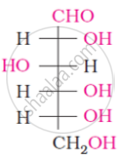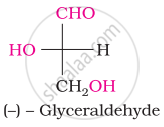Advertisements
Advertisements
प्रश्न
What happens when glucose is treated with hydroxylamine?
उत्तर
Action of hydroxylamine (NH2OH) on glucose: The reaction of glucose with
hydroxylamine gives an oxime. This indicates the presence of carbonyl group.

APPEARS IN
संबंधित प्रश्न
Write the reaction that indicates the presence of -CHO group in glucose
Draw the simple Fisher projection formulae of D - (+) - glucose and D - (-) - fructose
How many moles of acetic anhydride will be required to form glucose pentaacetate from 2M of glucose?
(a) 2
(b) 5
(c) 10
(d) 2.5
Enumerate the reactions of D-glucose which cannot be explained by its open chain structure.
Maltose is a
(a) Polysaccharide
(b) Disaccharide
(c) Trisaccharide
(d) Monosaccharide
What happens when glucose is treated with hydrogen cyanide?
Write the product when D-glucose reacts with conc. HNO3.
Differentiable between the following:
Amylose and Amylopectin
What do you observe when glucose solution is heated with Tollen’s reagent?
Write the reactions involved when D-glucose is treated with the following reagent:
Br2 water
The following compound can be called as:

The number of asymmetric carbon atom(s) below the figure is/are


Oxime is formed by treating glucose with ____________.
Which of the following properties of glucose cannot be explained by its open chain structure?
(i) Glucose does not form hydrogen sulphite with NaHSO3.
(ii) On oxidation with HNO3 glucose gives saccharic acid.
(iii) Glucose is found to exist in two different crystalline forms which are named as α and β.
Glucose is found to exist in two different α and β crystalline forms. These forms can be obtained by:
(i) The α form of glucose is obtained by crystallisation from a concentrated solution of glucose at 303 K.
(ii) The β form of glucose is obtained by crystallisation from a concentrated solution of glucose at 303 K.
(iii) The β form is obtained by crystallisation from hot and saturated aqueous solution at 371 K.
(iv) The α form is obtained by crystallisation from hot and saturated aqueous solution at 371 K.
The two forms of D-glucopyranose obtained from the solution of D-glucose are called ____________.
The letter D and L in carbohydrates represent ____________.
In the following reaction, identify A and B:
\[\begin{array}{cc}
\ce{C6H12O6 ->[Acetic anhydride] A}\\
\downarrow \text{Conc. nitric acid}\phantom{...}\\
\ce{B}\phantom{.................}\end{array}\]
Which of the following pairs represents anomers?
How will you distinguish 1° and 2° hydroxyl groups present in glucose? Explain with reactions.
Write the reactions of D-glucose which can’t be explained by its open-chain structure. How can cyclic structure of glucose explain these reactions?
Account for the following:
There are 5 OH groups in glucose
Glucose with excess of phenyl hydrazine forms ______.
The number of asymmetric carbon atoms in the glucose molecule in open and cyclic form is ______.
Match List - I with List - II.
| List I | List II | ||
| (A) | Glucose + HI | (I) | Gluconic acid |
| (B) | Glucose + Br2 water | (II) | Glucose pentacetate |
| (C) | Glucose + acetic anhydride | (III) | Saccharic acid |
| (D) | Glucose + HNO3 | (IV) | Hexane |
Choose the correct answer from the options given below:
